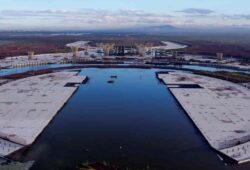Many people vouch for the value of learning how to convert RV water heater to tankless.
They claim that it is the best way to cut costs while ensuring a good supply of clean water on-demand.
The truth is that tankless is certainly the way to go. Being that your RV is basically your house on wheels, you want to make sure that you’ve got a steady supply of water without costing you a fortune.
And it is no secret that an RV water heater can quickly hike up your expenses. So, is converting to tankless really the way to go? If so, how is it done? We’ll discuss the surprisingly easy steps on how to convert RV water heater to tankless in the next sections below. Keep reading and prepare to save money sooner than later!
Contents
Why You Need to Know How to Convert RV Water Heater to Tankless
First, let’s talk about the why’s.
Why should you even bother learning how to convert RV water heater to tankless? Is it worth your time and energy?
For the most part, it is a way to get clean and ample hot water.
Since you are no longer storing your water in a tank, then obviously you can get cleaner water. Stored water gets dirty over time, and that is not a great idea when you use it for drinking or cooking.
By going tankless, you are saving yourself from potential diseases that come from consuming unclean water.
Another reason why a tankless water heater is better is its energy-efficient feature. Tankless does not use too much gas. You can get your water nice and hot as you want it while at the same time saving on fuel expenses.
And lastly, tankless saves you a ton of space. With the little space you already have in your RV, wouldn’t it be great to free up some room that a tank takes up?
Just imagine what you can do with the additional space you’ve got by replacing your bulky tank with a slimmer tankless water heater?
So, you know the why’s and you’re probably wondering how to convert RV water heater to tankless. But before you jump right into it, let’s discuss certain aspects of this task in the next section.
Getting Started: How to Convert RV Water Heater to Tankless

This is not a big secret: Figuring out how to convert RV water heater to tankless is a massive project.
It is complex and even challenging for many people. But if you’re the kind of person who has decent technical insight and skills, and you’ve got the right tools (and know how to use them), then you can turn this into a weekend DIY activity.
The most important thing to keep in mind is safety. You need to make sure that you know perfectly well the protocols and safety practices when it comes to dismantling and reconnecting your propane and electrical supplies. Never hesitate to obtain professional assistance if you are uncomfortable with all of these.
The main premise of learning how to convert to tankless is disconnecting your old water heater from the supply lines. So, you’ve got your electrical supply, as well as your propane lines.
After performing that, you can now clear your old heater’s exterior flange that’s got a weatherproof sealant. This means that you have to take out the mounting fasteners, remove the mounting flange, and then slide out the old unit.
With all these said and done, you can do a quick cleanup of the area, put the new heater right into place, and then reconnect the service supply lines.
Sounds easy? It can be a bit complicated once you’re at it. But we’ll help you get an idea of the steps you need to take.
Read More: How Much Electricity Does An RV Use In One Month? Surprising Facts For Every RV Owner
Figure Out the Best Tankless Heater
Naturally, you want to take some time to shop for a suitable tankless heater as a replacement. The good news is that many RV water heaters follow dimension and fitting standards, so you should not have a tough experience buying the right kind.
Check the dimensions, which should be a good fit for your old one. The venting system should also be in the exact same position as the previous heater. This way, you don’t have to go out of your way and spend a ton of money on re-doing your RV’s structural system.
And lastly, check the propane connections and fittings. Compatibility is key, which will spare you from unnecessary delays and additional costs that come with converting the wrong heater.
Once you’ve got these bases covered, you are ready to proceed.
Gather All Your Supplies
At this point, you need to have your tools ready.
There’s nothing fancy here; basically just the basics such as adjustable wrenches, screwdrivers, chisel, hammer, pliers, and screws. If you have a cordless battery drill, that’s even better.
There may be some spills and messes, so have some rags available, as well. You can also prepare your caulking sealer applicator, some electrical insulation tape, and maybe even a sealing tape.
Remove the Old Water Heater
First, you need to isolate all your propane supplies, water and electrical to your old heater. If there are other people in the RV, tell them to not switch on anything while you are working on it.
Drain your old water heater but make it a point to prevent the water outflow from causing electrical shorts that are in the way. Check for the drain valve, open this unit, and let the tank drain thoroughly.
When it is all emptied out, disconnect it from your supplies. Everything should still remain isolated, and you can disconnect the electrical piece from the old water heater.
A cool hack to do is to take pictures of the wires to guide you best when it’s time to reconnect.
Remove the cold and hot water lines, which you can find at the bottom of your old heater. Mark the wires if not color-coded. You should also neatly place loose fittings in a secure spot, which you would need later on.
Lastly, remove the propane line and use a plastic bag or rag to wrap the open end. This prevents any debris from getting into this exposed line.
When all of these lines are already disconnected, you can remove the old water heater. There should be no line snagging on your heater as it can cause damage.
Put all loose fittings in one place, as well as the flange and screws. You may need these later if the unit fails to work for some reason.
Install the New Tankless Heater
Prepare the location by cleaning off the old sealant. This is where your chisel and paint scraper can come in handy. This process allows you to seal the new heater flange securely and correctly.
Set the new heater while still outside the RV. This gives you more space to get it ready before you slide it into the recess. Just be sure that there are no snags or hang-ups that can be a major safety issue to everyone in the RV.
Then, you can proceed to reconnect the electrical and water lines. Never cross-thread and do not over-torque your fittings. Otherwise, this can break things and cause them to fail.
After all of these tricky internal and external connections, you can place the screws back on the exterior flange. Use a silicone sealer to seal up the unit and trim the excess sealer off after tightening the screws in place.
And there you have it – it’s all good to go.
Now, you can start tidying up and testing your new tankless water heater. Get a good shower and check if everything is in place. If so, then you can take a deep breath knowing that you are now well on your way to saving money, having clean hot water all the time, and getting rid of the bulk in your RV!
Final Thoughts
There are many reasons why converting your old heater to tankless is a great idea.
It is more energy efficient, will save you money, and you can keep yourself healthy with cleaner water at all times.
We hope these tips on how to convert RV water heater to tankless have been helpful. Best of luck with the new installation and enjoy your new tankless heater!




